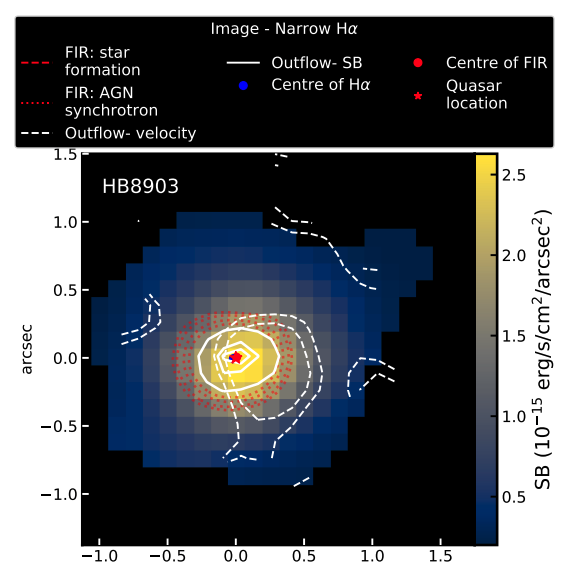CEA News, August 2021
The impact of ionized outflows from z 2.5 quasars is not through instantaneous in situ quenching
It is now accepted that inside every massive galaxy resides a supermassive black hole. During the growth of these supermassive black holes, via accretion events, these objects become visible as active galactic nuclei. Current theoretical models of galaxy evolution require AGN to inject significant energy into their host galaxies in order to reproduce the basic properties of local galaxies and the intergalactic medium (IGM), such as the steep mass function, the black hole–spheroid relationships, increased width of specific star formation rate distributions as a function of stellar mass, galaxy sizes, galaxy colour bi-modality, AGN number densities and enrichment of the IGM by metals. CEA astronomers present high-resolution ALMA band 7 observations of three powwerful z~2.5 quasars to investigate potential supressed star formation.
 An exapmle of the spatial distribution of FIR emission (red contours), surface brightness of narrow H𝛼
emission and AGN-driven outflows (white contours) for one of the three quasars.
An exapmle of the spatial distribution of FIR emission (red contours), surface brightness of narrow H𝛼
emission and AGN-driven outflows (white contours) for one of the three quasars.
In a recent paper led by astronomers at the CEA, ALMA observations are combined with a re-analysis of the VLT/SINFONI data to map the rest-frame far-infrared emission, H𝛼 emission, and [O iii] emission. In all targets they observe high velocity [O iii] gas across the whole galaxy. They do not identify any H𝛼 emission that is free from contamination from AGN-related processes; however, based on SED analyses, the paper shows that ALMA data contains a significant dust-obscured star formation component in two out of the three systems.
In summary, the team finds that within the resolution and sensitivity limits of the data, they do not see any evidence for a instantaneous shut down of in-situ star formation caused directly by the outflows. However, similar to the conclusions of previous studies and based on our measured star formation rates, they do not rule out that the global host galaxy star formation could be suppressed on longer timescales by the cumulative effect of quasar episodes during the growth of these massive black holes.

